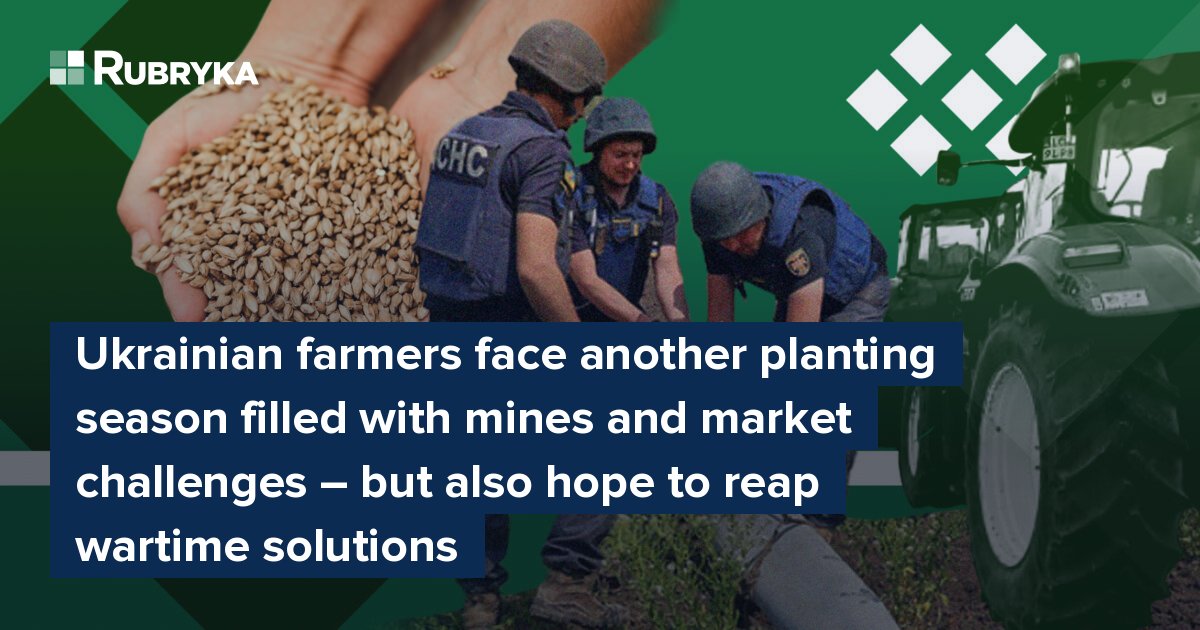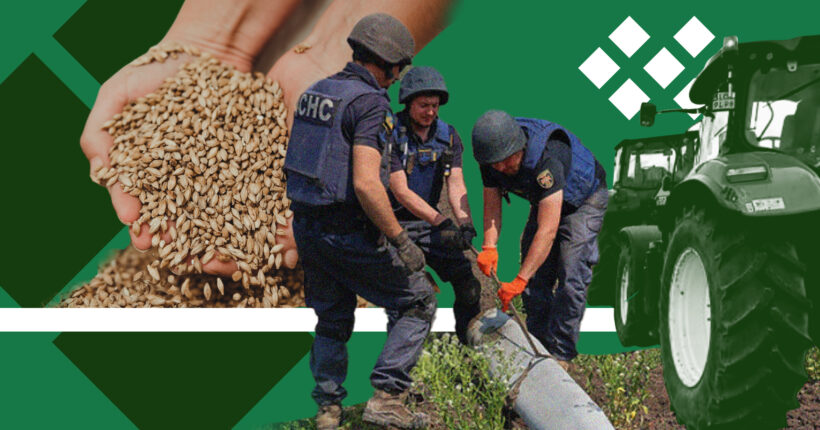
What is the problem?
The situation in the agricultural sector of Ukraine is difficult today. However, there are solutions that Ukrainian farmers are already implementing today to improve it, and the sowing campaign is ongoing despite all.
Mined lands, loss of land, equipment, crops, and strained grain corridors were only part of the challenges Ukrainian farmers faced in 2022, and the 2023 agricultural year is shaping up to be no less stressful for Ukraine's agricultural sector. Nevertheless, maintaining food security is a crucial goal for Ukrainian agrarians.
Mines endanger crop planting
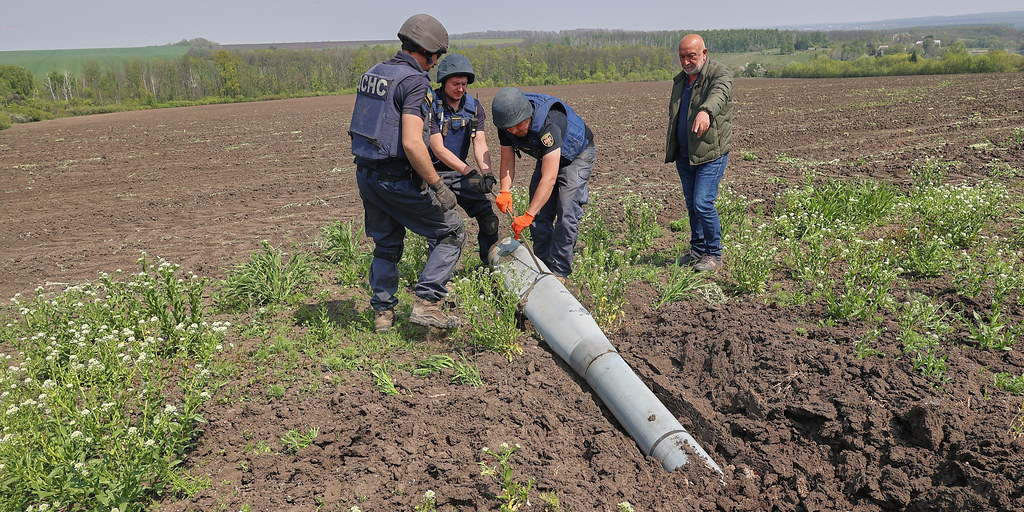
Field demining work is in progress. Photo: Kharkiv Today
Over 170,000 square kilometers of Ukrainian territory remain dangerous due to remnants of war such as landmines and unexploded shells. Suzanna Hryhorenko, the director of the Seed Association of Ukraine, says that sowing will be carried out only on the part of Ukraine's liberated territory, since demining efforts are prioritizing critical infrastructure facilities, and farmers can only wait, as their fields sit empty. The de-occupied parts of the Kherson, Mykolaiv, and Kharkiv regions are the most affected by mines.
Farmers in the Kherson region who spoke to The New York Times are sure that the occupiers are deliberately mining Ukrainian fields to harm the industry and undermine food security.
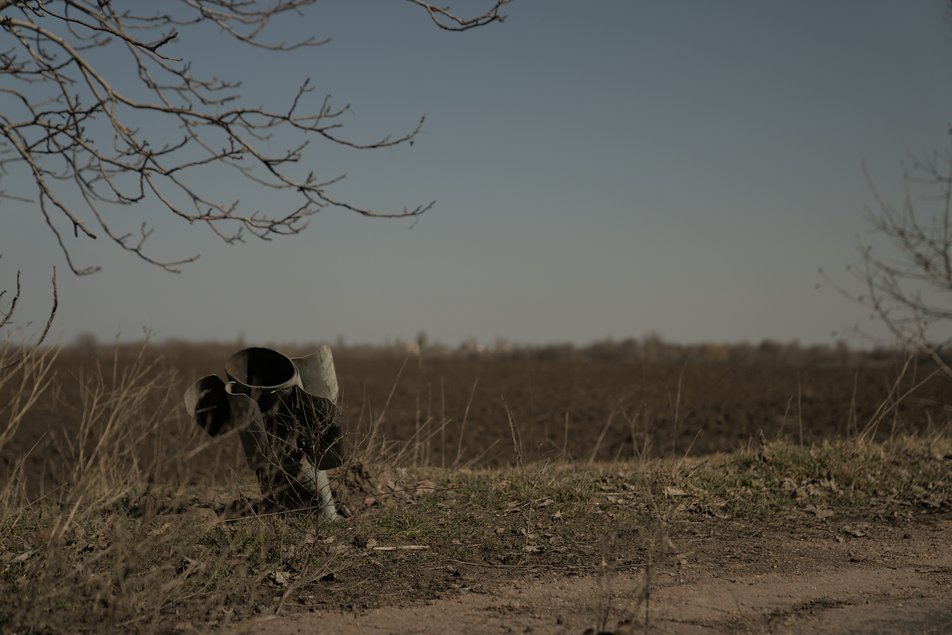
The field damaged by the shelling. Photo: Suspilne
"Usually, farmers go around dangerous areas, mark places where they have spotted mines, and then, at their own peril and risk, plant fields that seem safe to them," says Hryhorenko.
According to the Ukrainian agrarian ministry, about 24% of the land will not be sown this year, which is almost seven million hectares – or 17 million acres.
Hryhorenko says she is sure that this will be the most challenging planting season ever, especially for areas recently freed from Russian occupation, whose consequences will continue to be felt long after the war is over. This creates a bittersweet situation for farmers in the liberated territories: though their land has been returned to them, they cannot yet earn an income from them.
Lack of funds
The Veselka farm is located in the Dnipropetrovsk region, 50 km from the line of hostilities. The deputy head of the enterprise, Maryna Sushko, says that the community was not subjected to regular enemy shelling, so the farmers were able to continue working without interruption both last year and this year. Although investment has been curtailed, Veselka has been able to continue working despite the war.
The biggest challenge for them, as well as most farmers of Ukraine, is making ends meet with the working budget for the 2023 sowing season.
"To put it mildly, due to the low prices for the sale of grain and technical crops in 2022, our company sold a small number of products of its own production — exclusively to cover urgent needs," shares Sushko. "Most of the products remained in storage for sale in 2023. Accordingly, the financial statements of our company for 2022 look less attractive than in previous years."
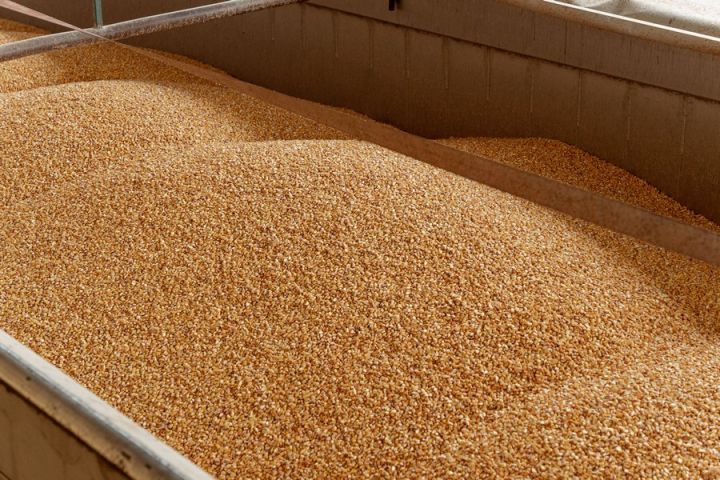
Photo: Elevatorist.com
Taking a bank loan is also more difficult for the enterprise. Given the reporting, banks consider it risky to lend to a client that isn't making profits. The calculation of lending limits is done automatically, according to the specified parameters, including the profit for a certain period.
The algorithms banks use to make credit decisions do not particularly consider the specifics of agricultural enterprises, nor conditions unique to wartime. Last year, Veselka tried to adapt by store products as long as possible to wait for an attractive selling price. But because the bank, Sushko says, was not satisfied with the income on their ledgers, she was not approved for financing this year.
Since the planting season has already started, Veselka will need to adjust its business plans and use less heavy machinery and fertilizers — which will cut costs in the short term, but will affect its future producing capacity, says Sushko.
"Everything became more expensive… except agricultural products"
According to Hryhorenko, this year, farmers are choosing crops that are simple to grow and store and have high sales potential.
Also, due to a lack of finances, the preparation procedure for sowing has changed. If, before the war, farmers bought seed material in advance in the fall, they now buy it in the spring, just before sowing waiting for an ease in prices that have increased by an average of 15-20%. Andrii Ostapenko, director of Art-Agro, a pesticides company and the owner of a small farm, says that profit margins were particularly impacted by the breakdown of logistics routes due to the war.
Small farmers used to move their products through local transporters, who would load them onto trains bound for the port cities of Odesa or Mykolaiv, in Ukraine's south. From there, grain sailed out to global trade routes on barges.
Now that the regular route of rail and sea transport has been disrupted by Russian occupation of Ukraine's south and partial blockade of its territorial waters – logistics has become much more expensive. While getting Ukrainian grain out to market via sea trade routes used to cost producers an average of $35 per ton — grain transported by road can cost as much as $100 per ton, according to Ostapenko.
Hryhorenko says that trading with an unstable global market is a perennial problem for agrarians, and even more so in a time of war and constant uncertainty. The authorities of Ukraine and international partners are taking all necessary measures to export grain abroad successfully. Despite efforts by Ukrainian authorities and international partners to keep trade moving, Russia continues to impose its naval presence in Ukraine's territorial waters and detain commercial vessels for extralegal "inspection". Though they are far from the field of battle, these acts of aggression have a significant impact on Ukrainian crop producers and traders.
Automobile exporters, too, learned to work in extreme conditions during the past year of war. In most cases, companies had already-developed routes. Meanwhile, Ukraine's public railway company Ukrzaliznytsia, is actively developing cooperation with European railways to establish direct cargo shipments from Ukraine to Europe.
"I am now seeing news that Romanian, Polish, and Bulgarian farmers are protesting against the import of cheap Ukrainian-made agricultural products into their territory," says Sushko. "As a representative of the Ukrainian agricultural producer, I understand and sympathize with my European colleagues. And I do not object to buying Ukrainian-made products at European prices. Just imagine that the selling price of products, which includes logistics costs and all the risks associated with military actions, is still lower than the pricing of the European products."
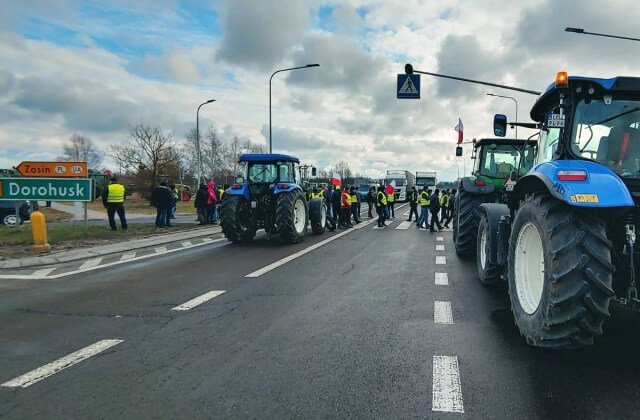
Polish farmers are protesting against the low prices of Ukrainian products. Photo: Oburene Selo
This situation is created because the oversupply in the market effectively forces Ukrainian agricultural producers to sell their products at low prices that do not even cover the costs incurred for their production.
"Everything changes constantly and quickly," says Ostapenko. "At the beginning of 2023, many farmers, including us, planned their sowing, placing a bet on [vegetable] oil crops, but global quotations show a drop in the prices of rapeseed, sunflower, and soybeans."
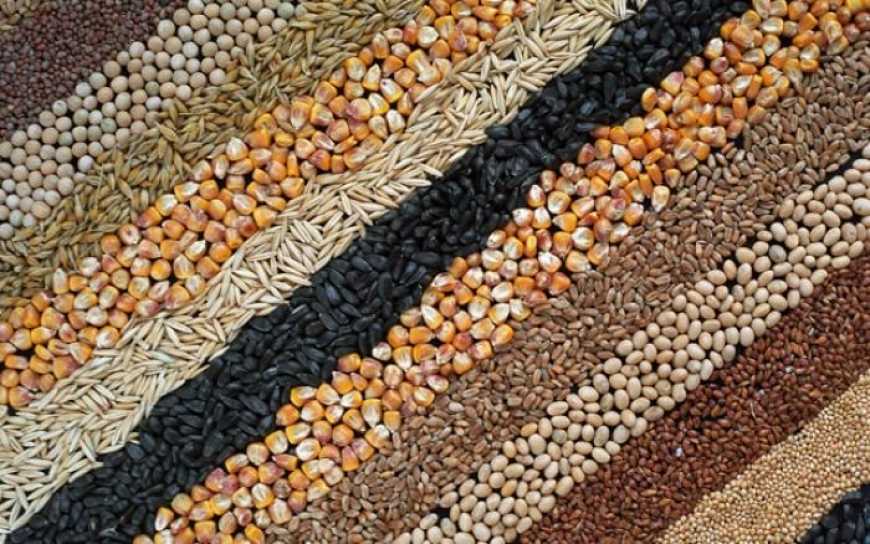
Compared to industrial crops, the low sale prices of cereals in the 2022-2023 fiscal year have already affected the structure of crops in 2023, reduced the market share of grains. In 2023, there may be an overproduction of industrial crops, and, as a result, a decrease in their sales prices. A grain shortage is also possible.
"Our enterprise is still unable to sell barley of the 2022 harvest. There is simply no demand for it," says Sushko. "Accordingly, we refused to plant barley this year, and we are far from alone." Sushko hopes that the market will balance out and that domestic sales can ensure at least a minimum level of profitability for Ukrainian agricultural producers.
"Warm bath of raw appendage"
"Ukraine's agribusiness has been following the path of raw materials since independence. This way is like a warm bath — comfortable and convenient. But it is mostly false," Ostapenko warns.
This is not only a wartime problem – just acutely manifested during the crisis. The routine of growing grain, selling it and reinvesting the revenue has worked effectively for years. However, without sufficient domestic demand, Ostapenko says, Ukrainian farmers fell into the trap of dependence on world prices and the international situation.
Ostapenko says that while prioritizing global exports are a faster route to profitability than more sustainable models, for example, creating a "closed loop" production cycle – in which crop excess can be reused on other parts of the farm, such as processing grain into the meat – as soon as the global market shakes, that profitability becomes vulnerable.
What is the solution?
State support: The "5-7-9 program" and tax cancellation
In March 2023 the Ukrainian government extended financing from the previous year to farmers under the "5-7-9 program," which offers incentives for job creation and loans at sliding scale interest rates as low as 5 percent. With the onset of martial law, a legislative initiative also began to cancel land taxes and rent in areas that witnessed hostilities.
Sushko mentions that in 2022, the Veselka farm received $84 per hectare in state support and used an interest-free loan under state guarantees, which significantly supported the farm's financial condition.
International support, grant opportunities
A program from the US Agency for International Development, USAID Agro is being implemented for small and medium-sized agricultural enterprises. At the end of 2022, USAID held a tender to purchase sunflower seeds. The program has resumed accepting applications for providing corn seed material to farmers. You can find other opportunities from USAID Agro at its website.
The Danish Refugee Council (DRC) runs a co-investment program to support Ukraine's agricultural sector and food production, providing grant support up to $20,000 for projects where the grantee contributes 50% of the project budget.
An important step is introducing the Agricultural Knowledge and Innovation Systems (AKIS) on the Ukrainian market, thanks to which farmers can obtain the necessary knowledge and implement agricultural innovations in their own production.
There is also the Advantage Ukraine government platform, through which investors worldwide support Ukrainian businesses, including the agricultural sector.
In March 2023, the Veselka enterprise received a grant to purchase a gas station with a capacity of 2.5 tons with the support of the Public Union Business Network of Rural Women.
According to Sushko, this acquisition will allow Veselka to buy diesel fuel at wholesale prices, and reduce its dependence on the availability of diesel fuel at the nearest gas stations.
The French agribusiness model
"I am sure that modern Ukrainian farmers are able to create a closed agricultural production cycle," says Ostapenko. "For example, you grow corn and have about a hundred piglets or cows next to it. Then you pass your harvest through meat and milk. This is a ready-made product, which will not be so strongly affected by the situation of the world market. What we see now is that the price of corn has fallen, but not for chicken and pork."
Ostapenko believes that a reorientation to the domestic market, combined with sustainable farming practices such as a "closed loop" are solutions that can save Ukrainian farmers from the troubles of war and the volatility of global markets.
According to Ostapenko, the agricultural sector is also experiencing a shortage of personnel — many men are called up to the front, and agricultural holdings are particularly affected. There is already a shortage of machine operators, for example. Ostapenko believes that while big agricultural holdings can't swiftly and efficiently react to such drastic changes, family farms could be more flexible in such situations. So some Ukrainian farmers are already switching to the so-called French agribusiness model with small family farms as the basis.
Ostapenko is sure that today's crisis simultaneously opens up good opportunities for family farms. If you want to earn money, he says, you work on the land. The transition to the French model can be a way out for the Ukrainian agricultural sector.
Joint export capacities
Exporting products abroad used to be the privilege of large agricultural holdings, but even small farms can see their products on the global market through merging smaller enterprises into cooperatives. By joining forces, crop producers can purchase seeds, fertilizers and pesticides at cheaper bulk prices, share storage capacity and machinery, and sell their products together at fair prices.
Sushko's farm is one of the members of the Agricultural Service Cooperative Zernovyi, which was established with the support of the Government of Canada and the Canadian non-governmental organization SOKODEVI. The Zernovyi cooperative currently brings together more than 100 participating farms with a combined capacity of 38,000 tons.
Whether navigating the fluctuations of a global market, or developing sustainable solutions at home, Ukrainian farmers are doing their best to plant seeds of growth, hoping they will grow into a more prosperous future.
Newsletter
Digest of the most interesting news: just about the main thing




